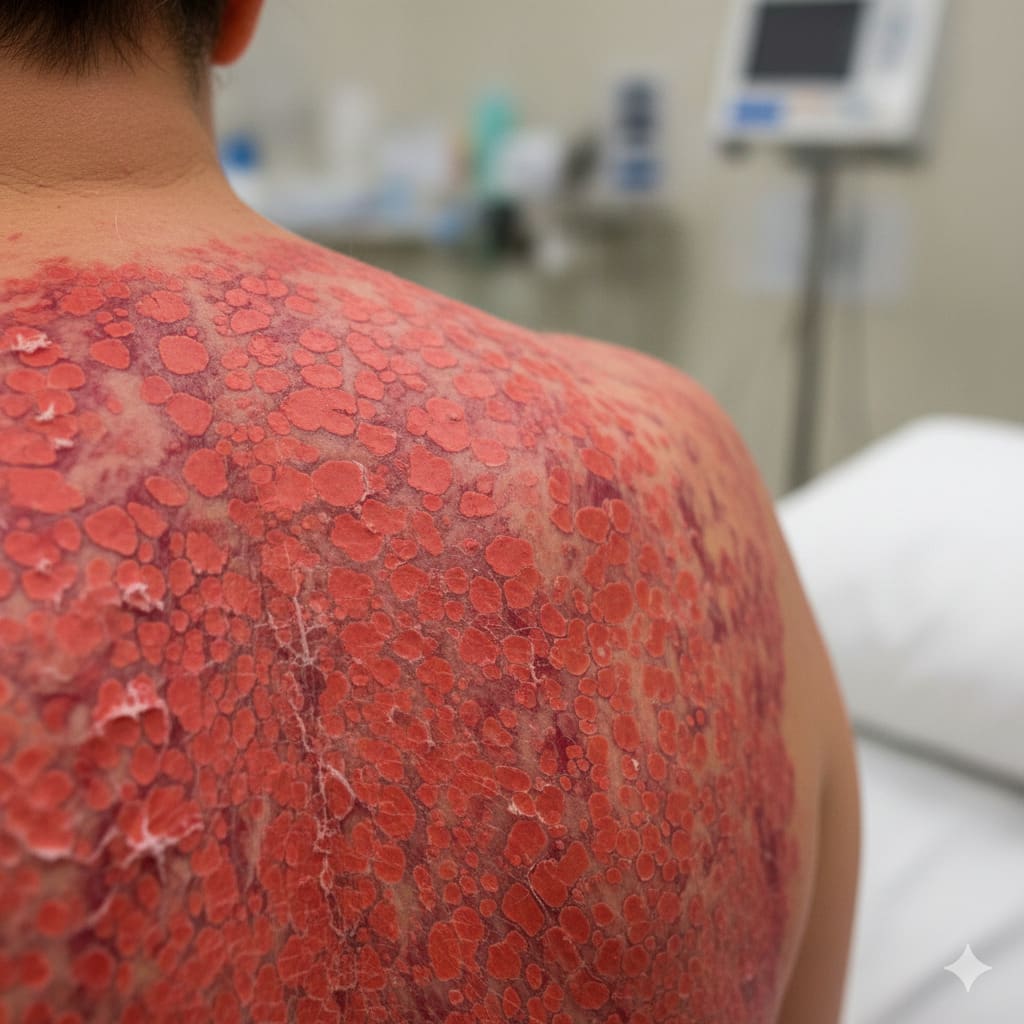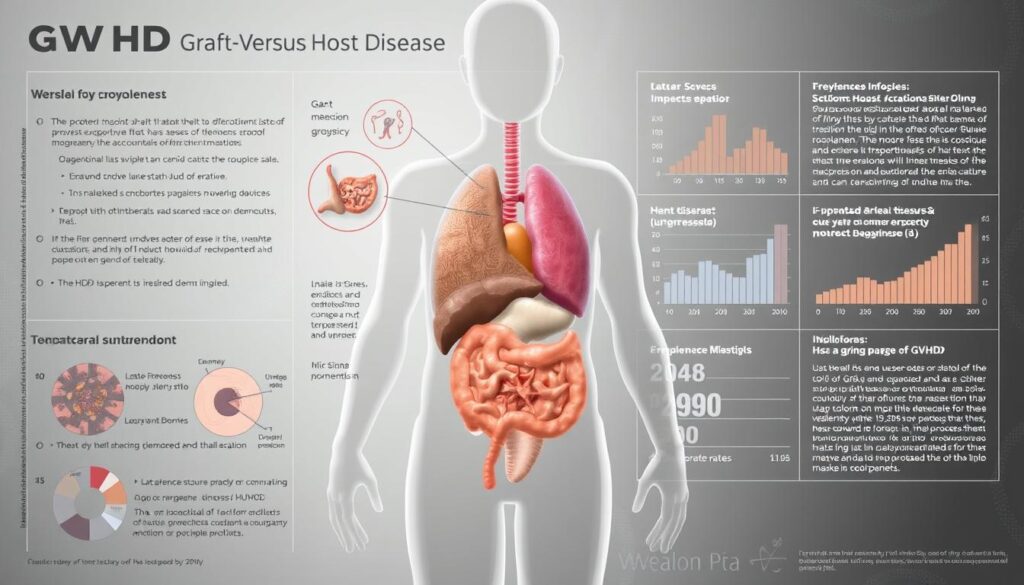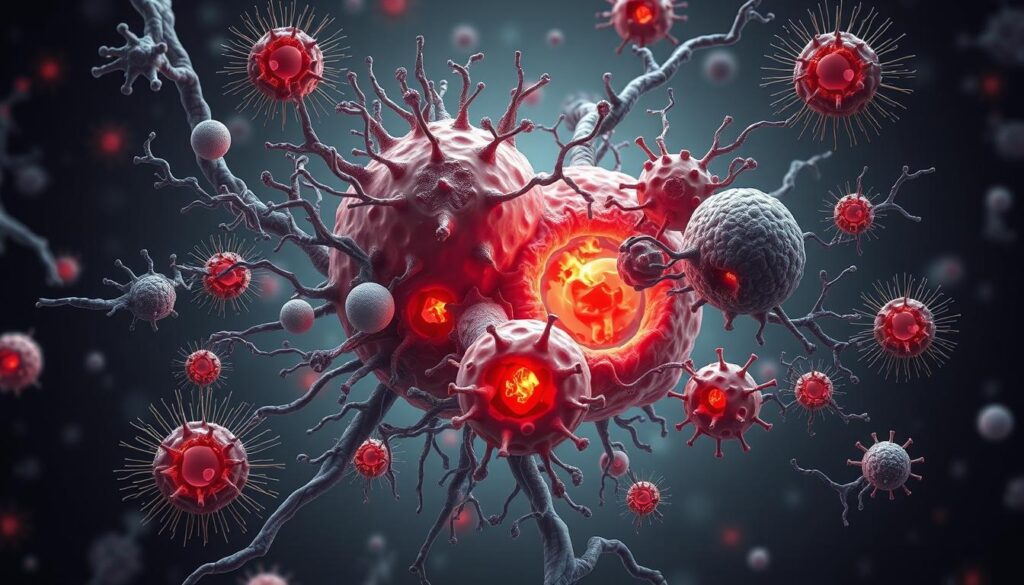
At Liv Hospital, we know that getting a stem cell or bone marrow transplant is tough. Graft-versus-host disease (GVHD) is a big problem that can happen. It’s when the donor’s immune cells attack the recipient’s body.
GVHD is a serious issue that can happen after a certain type of transplant. We focus on understanding GVHD, its signs, and how to treat it. This helps us give our patients the best care.
We aim to provide top-notch care with kindness and skill. Our team works hard to help patients deal with GVHD. We want to make sure they get the best results.

GVHD disease is a big problem after allogeneic hematopoietic stem cell transplantation. It happens when the donor’s immune cells see the recipient as foreign. Then, they attack the recipient’s tissues.
GVHD is when donor T cells harm the host’s cells. This can cause damage to tissues and organs. The severity of GVHD can vary widely, ranging from mild symptoms to life-threatening conditions. It starts when donor T cells recognize host antigens and get activated to cause damage.
“GVHD represents a major barrier to the success of allogeneic hematopoietic stem cell transplantation, necessitating a deep understanding of its pathophysiology to develop effective prevention and treatment strategies.”
GVHD affects a lot of patients who get allogeneic stem cell transplants. It’s estimated that 35% to 80% of recipients might get GVHD. The high prevalence and possible severity of GVHD make it very important in transplant medicine. Knowing about GVHD is key to better outcomes for transplant patients.

Understanding GVHD is key to finding better treatments. GVHD happens when the immune cells from a donor attack the recipient’s body. This is because the donor’s immune cells see the recipient as foreign.
The immune system is at the heart of GVHD. When donor immune cells meet the recipient’s body, they see it as foreign. This triggers an immune response against the host’s tissues.
T cells are key in this process. They are a type of lymphocyte that fights off infections. In GVHD, donor T cells attack the recipient’s tissues, causing damage and symptoms.
It’s important to tell GVHD apart from host-versus-graft rejection. These two conditions need different treatments. Host-versus-graft rejection happens when the recipient’s immune system rejects the graft. GVHD is when the graft’s immune cells attack the recipient.
“GVHD and host-versus-graft rejection are two distinct complications of transplant procedures, requiring different approaches to prevention and treatment.”
To tell them apart, doctors look at symptoms, lab results, and tissue samples. This helps them find the right treatment for each condition.
By understanding GVHD and how it differs from host-versus-graft rejection, doctors can improve care for transplant patients. This leads to better outcomes for those who receive transplants.
GVHD comes in two main types: acute and chronic. Each has its own set of symptoms and treatment needs. Knowing the difference is key to helping patients.
Acute GVHD happens early, usually within 100 days after a transplant. It can quickly affect the skin, stomach, and liver. Symptoms range from mild to severe, like rashes, nausea, and diarrhea. Quick diagnosis and treatment are vital to stop it from getting worse.
Chronic GVHD shows up later, often after 100 days. It’s a complex condition that can harm many organs. It causes long-lasting problems, such as skin issues, mouth problems, and liver issues.
Doctors classify chronic GVHD based on how severe and widespread it is. This helps decide the best treatment and predict how well a patient will do. Getting the diagnosis and staging right is key to managing chronic GVHD well.
Both acute and chronic GVHD are tough to manage. But by knowing the differences, doctors can tailor treatments to meet each patient’s needs.
GVHD symptoms can vary a lot, affecting many organ systems. This makes diagnosis and treatment hard. It’s key to understand these symptoms for good patient care.
The skin is often hit hard by GVHD. Patients may get a rash that can be mild or severe. “The skin rash associated with GVHD can be quite distressing for patients,” causing discomfort and impacting their life quality. We must watch these symptoms closely to help them.
GVHD can also hurt the stomach and intestines, causing nausea, vomiting, and diarrhea. These can lead to dehydration and malnutrition if not treated right. It’s critical to tackle these issues quickly to help patients recover.
GVHD can also harm the liver and other systems. Liver problems can cause jaundice and other issues, needing careful handling. Other systems like the eyes, lungs, and joints can also be affected, each with its own challenges.
It’s important to know the many symptoms of GVHD and which systems are affected. This helps healthcare providers create better treatment plans. By understanding GVHD’s complexity, we can offer more complete care.
It’s key to know the risk factors for GVHD to prevent and treat it well. GVHD is a big problem after stem cell transplants. Knowing what increases the risk helps doctors take better care of patients.
Donor factors are very important in GVHD. A big HLA mismatch between donor and recipient raises the risk. GVHD risk factors also include older donors. Older donors might have more immune cells, which can increase the risk.
Factors related to the recipient also play a big role. Older patients are at higher risk because their immune system is weaker. Other factors like the recipient’s health, infections, and past medications also affect GVHD risk.
The transplant procedure itself can also change GVHD risk. Things like the conditioning regimen and the source of stem cells matter. Using T-cell depletion techniques can also impact the risk.
Knowing these risk factors is vital for preventing GVHD. By identifying high-risk patients, doctors can take steps to lower the risk. This helps improve outcomes for those undergoing stem cell transplants.
Diagnosing GVHD needs careful steps. We use both clinical checks and advanced tests. Accurate diagnosis is key for good treatment and care.
First, we do a detailed check and look at symptoms. We search for signs like skin rash, stomach problems, or liver issues.
Clinical evaluation means looking at the patient’s medical history and doing a physical check. We see how bad the symptoms are and how they affect the patient’s life.
To be sure, we might take a biopsy of the affected area. Blood tests help us see how bad GVHD is and rule out other diseases.
Tests might include:
After diagnosing GVHD, we use grading and staging to see how severe it is. These systems help us predict the outcome and decide on treatment.
| GVHD Grade | Clinical Features | Prognosis |
|---|---|---|
| I | Mild symptoms | Favorable |
| II-III | Moderate to severe symptoms | Guarded |
| IV | Life-threatening symptoms | Poor |
Knowing the grade and stage of GVHD is vital for a good treatment plan. We make sure each patient gets the care they need.
Managing GVHD requires a mix of immunosuppressive therapy, supportive care, and special treatments for cases that don’t respond to steroids. It’s key for doctors to create a treatment plan that fits each patient.
The main treatments for GVHD start with first-line treatments. These usually include corticosteroids and other drugs that calm the immune system. The goal is to ease symptoms and improve how patients do.
First-line treatments often begin with corticosteroids. They help control the immune system. Doctors might also add other drugs to make these treatments work better.
When GVHD doesn’t get better with steroids, salvage therapies are needed. These can include different drugs, a treatment called extracorporeal photopheresis, or new methods to fight the disease.
Extracorporeal photopheresis is a promising treatment for GVHD that doesn’t get better with usual treatments. It offers hope for patients who haven’t seen improvement.
Supportive care is also very important in managing GVHD. It helps prevent infections, manages symptoms, and improves patients’ quality of life.
Supportive care includes infection prophylaxis, nutrition help, and counseling. These are all key to helping patients cope with GVHD and do better overall.
Stopping GVHD before it starts is a big challenge. It needs a mix of steps before and after the transplant. These steps are key to better results for patients getting stem cell transplants.
Before the transplant, there are steps to lower GVHD risk. These include:
These steps are vital for a successful transplant with less GVHD risk.
After the transplant, keeping GVHD at bay is ongoing. This involves:
Post-transplant care plans are made for each patient. They aim to stop GVHD while watching out for other risks and side effects.
GVHD disease, or graft-versus-host disease, is a big problem after allogeneic hematopoietic cell transplantation (allo-HCT). It’s key to manage GVHD symptoms well for patients to survive it. With the right diagnosis and treatment, patients can face GVHD’s challenges and live better.
Handling GVHD symptoms needs a full plan. This includes medicines, lifestyle changes, and constant medical care. Knowing how GVHD works helps doctors make treatment plans that fit each patient’s needs.
As we learn more about GVHD disease, we can help patients recover better. With the right care and support, patients can manage GVHD and enjoy a better life.
GVHD is a serious problem after a stem cell transplant from someone else. The donor’s immune cells see the recipient’s body as foreign. This leads to an immune reaction.
GVHD is divided into two types: acute and chronic. Acute GVHD happens early, within a few months. Chronic GVHD can start months or years later.
GVHD can affect many parts of the body. Symptoms include skin rash, diarrhea, stomach pain, and liver problems.
Doctors use several methods to diagnose GVHD. They look at symptoms, do biopsies, and run lab tests. They use grading and staging to measure how severe GVHD is.
Many things can increase the risk of getting GVHD. These include things about the donor and the recipient, and how the transplant is done.
There are different treatments for GVHD. First-line treatments are used first. For GVHD that doesn’t respond to these, there are salvage therapies. Supportive care is also important.
To prevent GVHD, there are steps before and after the transplant. These steps can lower the risk of GVHD.
GVHD is a big problem with stem cell transplants. It happens when stem cells from a donor are given to a recipient.
Yes, GVHD can be managed well. With the right understanding, diagnosis, and treatment, patients can overcome the challenges and live beyond the disease.
Chronic GVHD can affect many areas of the body. It can impact the skin, stomach, and liver. It can also greatly affect a person’s quality of life.
NCBI Bookshelf: Graft Versus Host Disease (StatPearls)
Blood Cancer United: Graft-versus-Host Disease Information
Leukaemia Foundation (Australia): Graft-versus-Host Disease (GVHD)
National Cancer Institute (NCI): Graft-versus-Host Disease (Cancer Terms)
Subscribe to our e-newsletter to stay informed about the latest innovations in the world of health and exclusive offers!
WhatsApp us